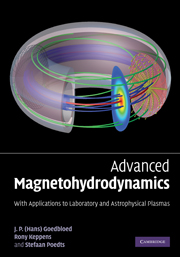21 - Ideal MHD in special relativity
Published online by Cambridge University Press: 05 March 2013
Summary
We have seen that the MHD description for the macroscopic dynamics of plasmas offers a uniquely powerful, unifying, viewpoint on both laboratory and astrophysical plasmas. The applicability of the MHD viewpoint was discussed previously in Volume [1], along with the various approximations made to arrive at the MHD equations from first principles. For most laboratory plasmas, the single fluid ideal or resistive MHD model eventually needs to be extended towards a multi-fluid model and by including important kinetic effects, since its continuum approach to plasma modeling neglected, e.g., Landau damping as well as many other velocity-space dependent physical phenomena. For many astrophysical plasmas, we face yet another shortcoming of the MHD model used thus far, namely that we restricted all attention to non-relativistic plasma velocities. This is perfectly adequate for most of the plasma found in our own solar system. However, astronomical observations indicate that, e.g., the extragalactic jets associated with Active Galactic Nuclei clearly harbor dynamically important magnetic fields and relativistically flowing plasmas. In order to model these plasmas in a continuum model, the restriction on the plasma velocities must be alleviated, by revisiting the ideal MHD equations in a frame-invariant relativistic formulation within fourdimensional space-time. In this chapter, we present such a formulation, restricting our attention to special relativity where we still have a “flat” geometry. In recent years, modern computational techniques such as those discussed in Chapter 19 have started to be used in this more demanding relativistic MHD regime. Since such activities are necessarily still maturing, we only summarize the numeric algorithmic challenges posed by the ideal MHD model in special relativity.
- Type
- Chapter
- Information
- Advanced MagnetohydrodynamicsWith Applications to Laboratory and Astrophysical Plasmas, pp. 543 - 590Publisher: Cambridge University PressPrint publication year: 2010



